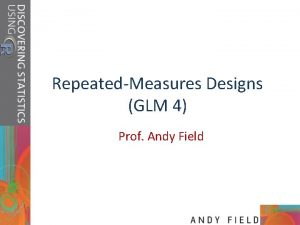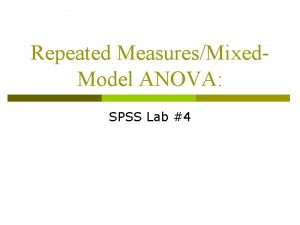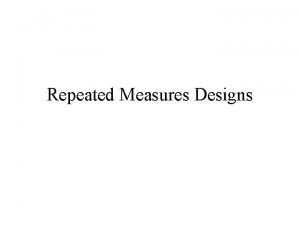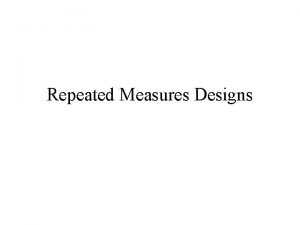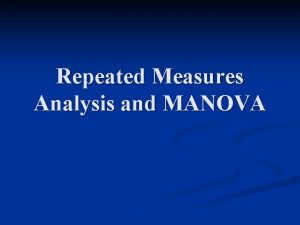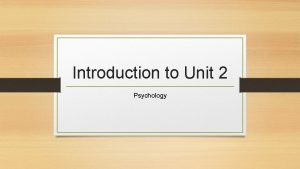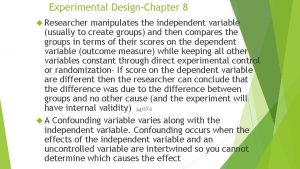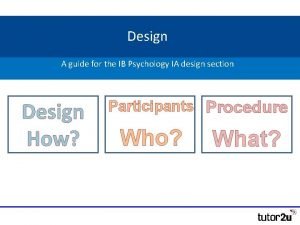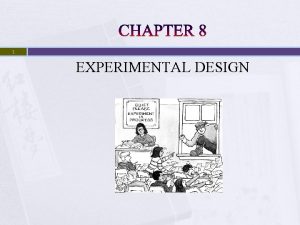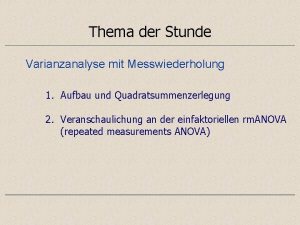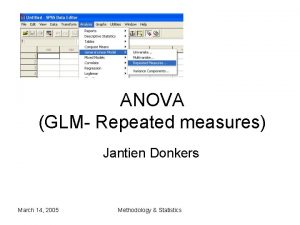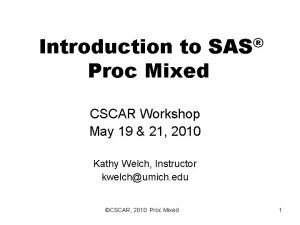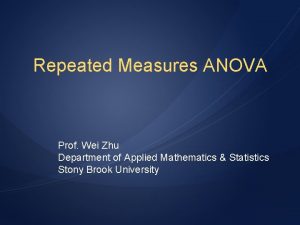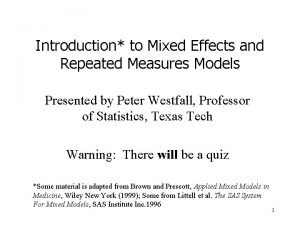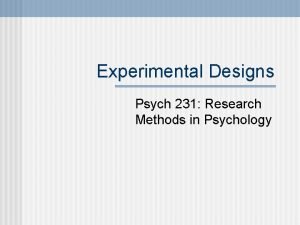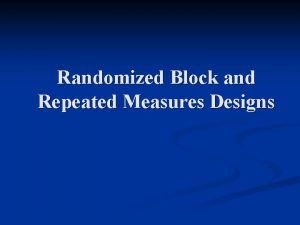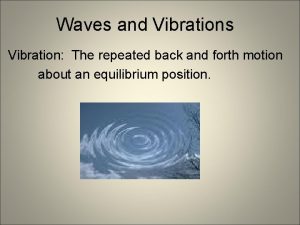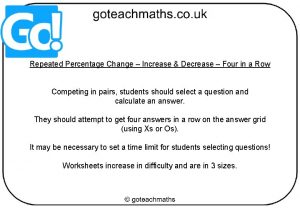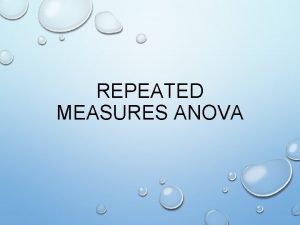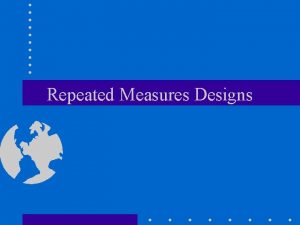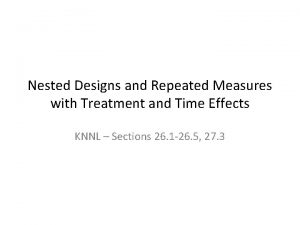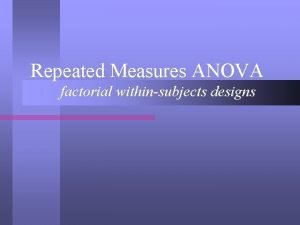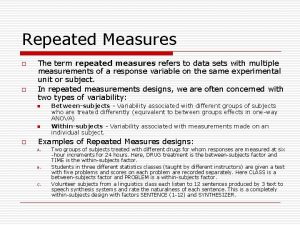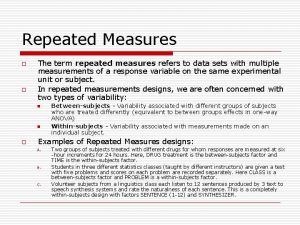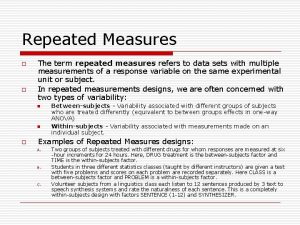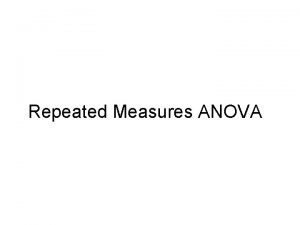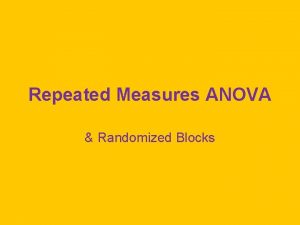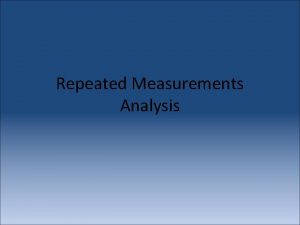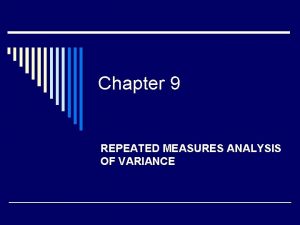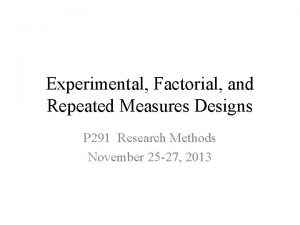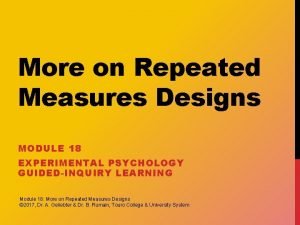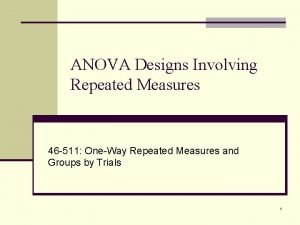Nested Designs and Repeated Measures with Treatment and




















- Slides: 20

Nested Designs and Repeated Measures with Treatment and Time Effects KNNL – Sections 26. 1 -26. 5, 27. 3

Nested Factors • Factor is Nested if its levels under different levels of another (Nesting) factor are not the same § Nesting Factor ≡ School, Nested Factor ≡ Teacher § Nesting Factor ≡ Factory, Nested Factor ≡ Machinist • If Factor A (Nesting) has a levels and Each Level of A has b levels of Factor B (Nested), there a total of ab levels of Factor B, each being observed n times A 1 Factor A Factor B Replicates B 1(1) Y 111 Y 112 A 2 B 2(1) Y 121 Y 122 B 1(2) Y 211 Y 212 A 3 B 2(2) Y 221 Y 222 B 1(3) B 2(3) Y 311 Y 312 Y 321 Y 322 Note: When Programming, give levels of B as: 1, 2, . . . , b, b+1, . . . , 2 b, . . . (a-1)b+1, . . . , ab

2 -Factor Nested Model – Balanced Case

Estimators, Analysis of Variance, F-tests

Fixed Effects Model (A and B Fixed)

Mixed Effects Model (A Fixed and B Random)

Random Effects Model (A and B Random)

Repeated Measures with Treatment and Time • Goal: Compare a Treatments over b Time Points • Begin with n. T = as Subjects, and randomly assign them such that s Subjects receive Treatment 1, . . . s Subjects receive Treatment a • Each Subject receives 1 Treatment (not all Treatments) • Each Subject is observed at b Time points • Treatment is referred to as “Between Subjects” Factor • Time is referred to as “Within Subjects” Factor • Treatment and Time are typically Fixed Factors • Subject (Nested within Treatment) is Random Factor • Generalizes to more than 1 Treatment Factor

Statistical Model

Analysis of Variance & F-Tests

Comparing Treatment and Time Effects – No Interaction

Comparing Trt Levels w/in Time Periods

Elements of Split-Plot Designs – RBD Case • Split-Plot Experiment: Factorial design with at least 2 factors, where experimental units wrt factors differ in “size” or “observational points”. • Whole plot: Largest experimental unit • Whole Plot Factor: Factor that has levels assigned to whole plots. Can be extended to 2 or more factors • Subplot: Experimental units that the whole plot is split into (where observations are made) • Subplot Factor: Factor that has levels assigned to subplots • Blocks: Aggregates of whole plots that receive all levels of whole plot factor

Split Plot Design – RBD Case Note: Within each block we would assign at random the 3 levels of A to the whole plots and the 4 levels of B to the subplots within whole plots

Examples • Agriculture: Varieties of a crop or gas may need to be grown in large areas, while varieties of fertilizer or varying growth periods may be observed in subsets of the area. • Engineering: May need long heating periods for a process and may be able to compare several formulations of a by-product within each level of the heating factor. • Behavioral Sciences: Many studies involve repeated measurements on the same subjects and are analyzed as a split-plot (See Repeated Measures lecture)

Design Structure – RBD Case • Blocks: b groups of experimental units to be exposed to all combinations of whole plot and subplot factors • Whole plots: a experimental units to which the whole plot factor levels will be assigned to at random within blocks • Subplots: c subunits within whole plots to which the subplot factor levels will be assigned to at random. • Fully balanced experiment will have n=abc observations

Data Elements (Fixed Factors, Random Blocks) • Yijk: Observation from wpt i, block j, and spt k • m : Overall mean level • a i : Effect of ith level of whole plot factor (Fixed) • bj: Effect of jth block (Random) • (ab )ij : Random error corresponding to whole plot elements in block j where wpt i is applied • g k: Effect of kth level of subplot factor (Fixed) • (ag )ik: Interaction btwn wpt i and spt k • (bc )jk: Interaction btwn block j and spt k (often set to 0) • e ijk: Random Error= (bc )jk+ (abc )ijk • Note that if block/spt interaction is assumed to be 0, e represents the block/spt within wpt interaction

Model and Common Assumptions • Yijk = m + a i + b j + (ab )ij + g k + (ag )ik + e ijk

Tests for Fixed Effects

Comparing Factor Levels
 Repeated measures design
Repeated measures design Andy field anova
Andy field anova Manova with repeated measures
Manova with repeated measures Repeated-measures design
Repeated-measures design Repeated measures design psychology
Repeated measures design psychology Manova with repeated measures
Manova with repeated measures Matched pairs design advantages and disadvantages
Matched pairs design advantages and disadvantages Hypothesis in psychology
Hypothesis in psychology Between groups design
Between groups design Repeated measures design psychology
Repeated measures design psychology Independent groups design
Independent groups design Repeated measures anova deutsch
Repeated measures anova deutsch Syntax editor spss
Syntax editor spss Glm repeated measures spss
Glm repeated measures spss Proc mixed syntax
Proc mixed syntax Two-way repeated measure anova
Two-way repeated measure anova Mixed model repeated measures
Mixed model repeated measures Carryover effects
Carryover effects Repeated measures anova jmp
Repeated measures anova jmp A repeated back and forth motion
A repeated back and forth motion Repeated percentage
Repeated percentage

